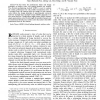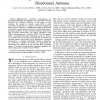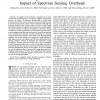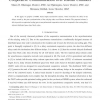138
click to vote
TWC
2010
14 years 7 months ago
2010
The goal of this paper is to explore the benefits of channel diversity in wireless ad hoc networks. Our model is that of a Poisson point process of transmitters, each with a recei...
TWC
2010
14 years 7 months ago
2010
In this letter the performance limits and design principles of rateless codes over fading channels are studied. The diversity-multiplexing tradeoff (DMT) is used to analyze the sys...
104
click to vote
TWC
2010
2010
Rex: A randomized EXclusive region based scheduling scheme for mmWave WPANs with directional antenna
14 years 7 months ago
Millimeter-wave (mmWave) transmissions are promising technologies for high data rate (multi-Gbps) Wireless Personal Area Networks (WPANs). In this paper, we first introduce the con...
TWC
2010
14 years 7 months ago
2010
We address the possibility of overloaded vector precoding in single user MIMO channels, i.e. the number of data streams is larger than the minimum of the number of antennas at tran...
119
click to vote
TWC
2010
14 years 7 months ago
2010
We investigate the problem of minimizing the overall transmission delay of packets in a multi-access wireless communication system, where the transmitters have average power constr...
131
click to vote
TWC
2010
14 years 7 months ago
2010
In cognitive radio networks, a cognitive source node requires two essential phases to complete a cognitive transmission process: the phase of spectrum sensing with a certain time d...
115
click to vote
TWC
2010
14 years 7 months ago
2010
In this paper, we propose a TDMA based simple transmission scheme, which overcomes the effect of the delays caused by the poor synchronization of the relaying nodes over Ricean ch...
100
click to vote
TWC
2010
14 years 7 months ago
2010
Abstract--In this paper, we propose a novel spectrum occupancy model designed to generate accurate temporal and frequency behavior of various wireless transmissions. Our proposed w...
TWC
2010
14 years 7 months ago
2010
A contemporary perspective on transmit antenna diversity and spatial multiplexing is provided. It is argued that, in the context of most modern wireless systems and for the operati...
126
Voted
TWC
2010
14 years 7 months ago
2010
In wireless ad hoc networks, relative neighborhood graphs (RNGs) are widely used for topology control. If every node has the same transmission radius, then an RNG can be locally co...




